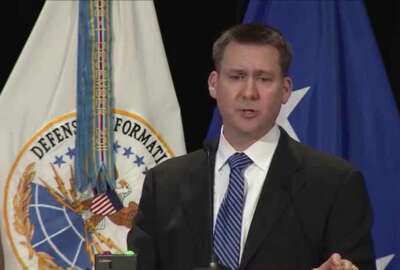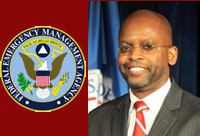 Exclusive
Exclusive FEMA, GSA gain new IT executives
FEMA named Lytwaive Hutchinson to replace Adrian Gardner as its new CIO while Reynold Schweickhardt joined GSA as a senior technology advisor.
It took nearly a year for the Federal Emergency Management Agency to find a new chief information officer.
A year after Adrian Gardner joined a long list of CIOs who were reassigned, FEMA’s search ended with a Defense Department veteran.
The agency quietly named Lytwaive Hutchinson as its new CIO in early May. Hutchinson came to FEMA after serving as the vice director of the Joint Service Provider in the Defense Information Systems Agency (DISA).

This is Hutchinson’s first civilian agency assignment. She spent 21 years as an active duty member of the Army and then joined Washington Headquarters Services in DoD in 2002 after retiring.
Patsy Garnett, who had been acting FEMA CIO since Gardner left, reassumes her previous position as the agency’s deputy CIO. Gardner retired in April after 30 years in government.
As the vice director of the JSP, Hutchinson developed, maintained and facilitated the implementation of the organization’s IT infrastructure across JSP’s customers. She oversaw an annual IT budget of more than $500 million, managed enterprisewide IT programs and initiatives, and served as the executive authority on the utilization of IT capabilities, resources, and systems.
As FEMA’s CIO, Hutchinson inherits major challenges to upgrade the agency’s IT infrastructure. In October, the Homeland Security Department’s inspector general told the House Homeland Security Subcommittee on Emergency Preparedness, Response and Communications that since 2005 auditors have found FEMA’s outdated IT systems and infrastructure did not enable it to effectively carry out disaster response and recovery efforts. The IG found significant and longstanding deficiencies that continue to hamper emergency support operations particularly around its ability to manage and track disaster funding and share information with external partners.
The IG also told lawmakers the CIO’s office lacks budget authority, formalized governance and oversight over IT investments and is missing an overall IT strategic plan.
FEMA is attempting to address some long standing IT challenges. In its fiscal 2020 budget request, FEMA asked for funding to reduce its complexity, such as $18.3 million to upgrade its network, $42.1 million to modernize its grants system and $8.1 million to address its aging financial management system.
It also asked for $9.1 million to continue “a multiyear effort to enable the agency to work smarter through data analytics and ultimately deliver better outcomes for survivors and communities. [The] Enterprise Data and Analytics Modernization Initiative will enable FEMA to streamline the work necessary to stay ahead of emergencies and deliver swift, effective assistance in times of greatest need,” DHS writes in its 2020 budget document.
Hill technology veteran comes to GSA
Along with FEMA, the General Services Administration is bringing in some new IT expertise.
Reynold Schweickhardt joined the agency as a senior technology advisor to “provide technology and cyber management perspective for GSA related technology initiatives,” according to his LinkedIn page.
This is Schweickhardt’s first experience in the executive branch after spending the last 24-plus years working for the legislative branch. He was the House of Representatives’ Director of Technology Policy for eight years before joining GSA. He also served as CIO and chief technology officer for the Government Printing Office.
While FEMA gained a technology executive, the U.S. Citizenship and Immigration Service lost one.
Eric Jeanmaire, the division chief for Identity, Records and National Security Delivery at USCIS, left government to become the CEO of Finality, a security engineering firm.
He spent nearly 10 years in government, including the last seven at USCIS working to modernize the E-Verify program.
Job openings at FDIC, Army Futures Command
Here are a couple of other interesting job openings in government:
The Federal Deposit Insurance Corporation (FDIC) is looking for a chief innovation officer for its Tech Lab (FDiTech). “The CINO will facilitate the transformation process by partnering with other FDIC divisions/offices, the Chief Information Officer organization, and the Office of the Chief Information Security Officer to strategically address challenges through the adoption of innovative technologies. Creates an environment that fosters and enables technological innovation and transformation within the FDIC, by building partnerships and serving as a change agent,” FDIC writes in the job posting.
The agency is accepting applications through May 29.
The Army’s Futures Command is looking for a director of futures integration within the Futures and Concepts Center.
The director will apply analysis to threats “through the lens of the unifying concept and recommends the Army Futures Command (AFC) ‘top-down’ requirements for inclusion in the Army Modernization Strategy and Annual Mission Guidance,” according to the job posting on USAJobs.gov.
The director also will direct the execution of plans and programs to ensure the Future Force Modernization Enterprise maintains consistency across warfighting functions, including synchronization of doctrine, organization, training, materiel, leader development, personnel, facilities and policy development actions, guiding requirements efforts of the nine FCC capabilities development and integrations directories (CDIDs).
Hurry up and apply, applications are due by May 17.
Copyright © 2025 Federal News Network. All rights reserved. This website is not intended for users located within the European Economic Area.
Jason Miller is executive editor of Federal News Network and directs news coverage on the people, policy and programs of the federal government.
Follow @jmillerWFED







